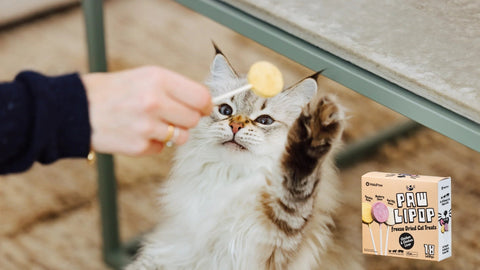Reading Time: 2 Mins.
As pet parents, we all love spoiling our little ones with delicious treats. However, with so many options available, it can be confusing to choose the right ones for our fur babies. Let’s explore the various types of pet treats, including freeze-dried pet treats, and discuss the differences, advantages and disadvantages of each. Let’s dive in!
1. Freeze-Dried Pet Treats – The Healthy Snack
What They Are: Freeze-dried pet treats are made by removing moisture from raw ingredients through a special freezing process. This preserves nutrients while keeping the texture light and crunchy.
Pros:
Nutrient-dense: Retains up to 97% of nutrients, making them a super-healthy choice.
Limited-ingredients: Great alternative for pets with sensitive stomachs. Plus, reduced risk of allergies if your little one is prone to them.
Long shelf life: Can last for years without preservatives.
Cons:
Cost: The special process involved makes these treats a bit more expensive- However, considering the longer shelf life, easy storage and nutritional value, the benefits outweigh the costs in the long run.
Might take some getting used to: While mostly an instant hit, some extremely picky eaters may take longer to warm up to these, especially if they are VERY used to a certain diet.
Best for:
Training sessions and pet parents seeking a high-protein, natural option.
Try MalsiPree’s hand-fed, freeze-dried dog treats & cat treats, designed for interactive feeding, to make bonding even more fun.
2. Chews – The Crowd-Pleaser

What They Are: These moist treats often contain glycerin to maintain softness, making them easy to chew.
Pros:
Great for seniors: The soft textures make these treats easier on aging teeth.
Great for teething pets: For teething pets that need something to gnaw on to relieve discomfort, chews are very helpful.
Keeps pets preoccupied: Given their soft texture, chews keep your pets engaged by themselves.
Cons:
Preservatives & fillers: Some categories of chews may be prepared with artificial ingredients.
Shorter shelf life: Can dry out quickly.
Best for:
Younger pets, senior pets or pets who get easily distracted.
3. Crunchy Biscuits – The Classic Treat

What They Are: Hard, baked treats that come in a variety of flavors, shapes and sizes.
Pros:
Affordable: Budget-friendly and easily available.
Disadvantages:
Lower nutritional value: Some contain "fillers" and artificial additives.
Not suitable for all pets: Can be too hard for puppies or seniors.
Best for:
Casual snacking.
Fun Fact:
The first dog biscuit was created in the 1860s by James Spratt, an electrician and lightning rod salesman from Ohio.
4. Jerky Treats – The Protein-Packed Favorite

What They Are: Thinly sliced and dried/dehydrated meat treats (mostly chicken, beef, and fish).
Pros:
High in protein: Great for active pets.
Natural ingredients: Often free from grains and fillers.
Chewing Satisfaction: Jerky treats last longer and satisfy chewing instincts.
Cons:
Can be tough to chew: Not ideal for pets with dental issues.
Best for:
A high-protein, natural alternative to processed chews!
Choosing the Right Treat for Your Little One
When selecting pet treats, consider your pet’s dietary needs, preferences and health conditions. Whether you need pet treats for bonding, pet treats for training, or just an occasional indulgence, there’s a perfect option for your little one.
Try MalsiPree's freeze-dried treats for training and bonding today.
For more pet care tips, personal care, and home & garden insights, sign up for our newsletter!
Happy pet parenting!
Team GoNorth



